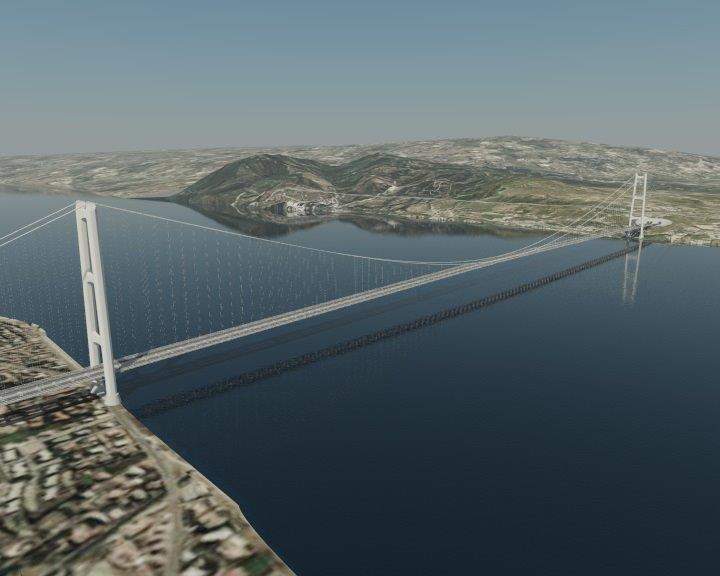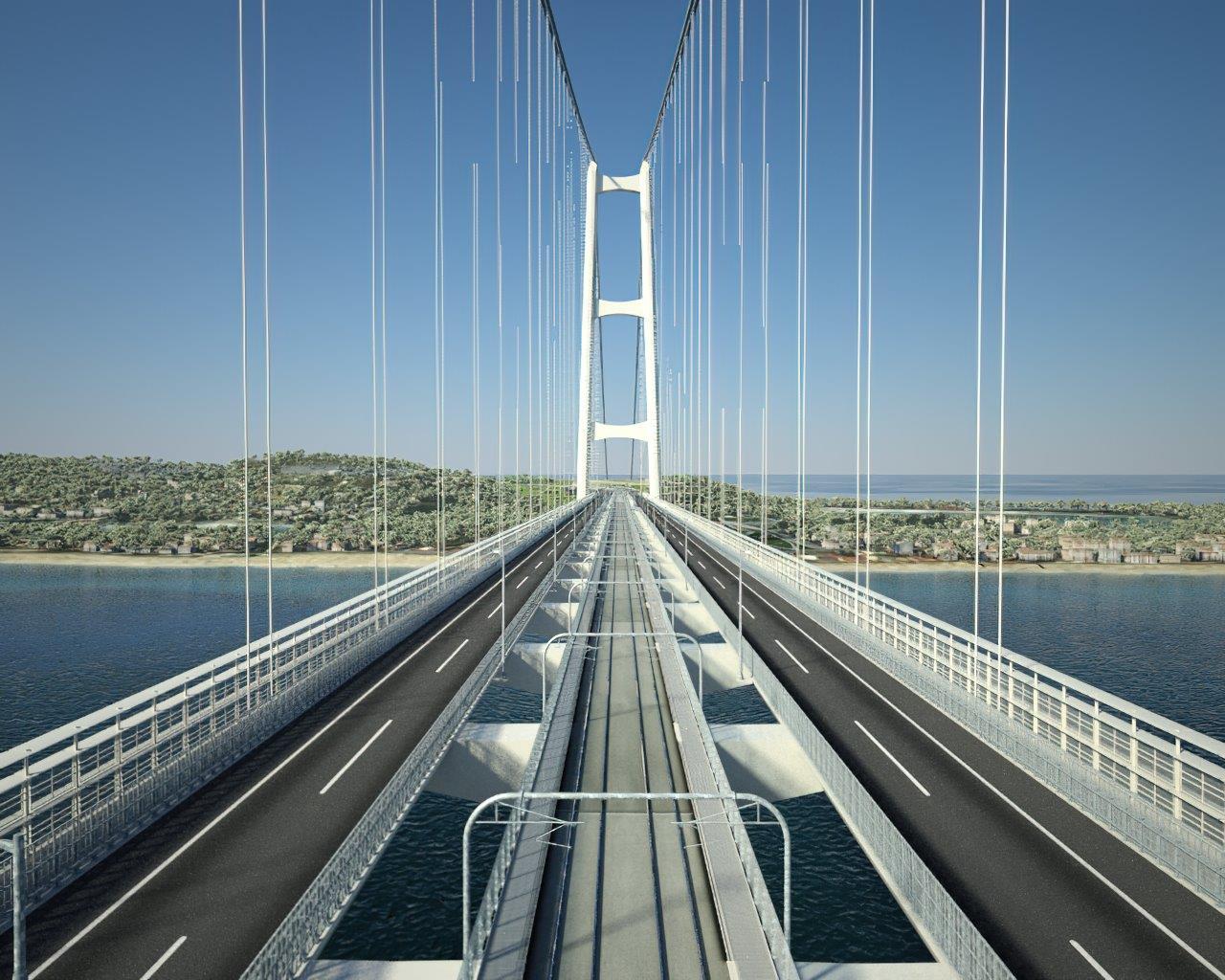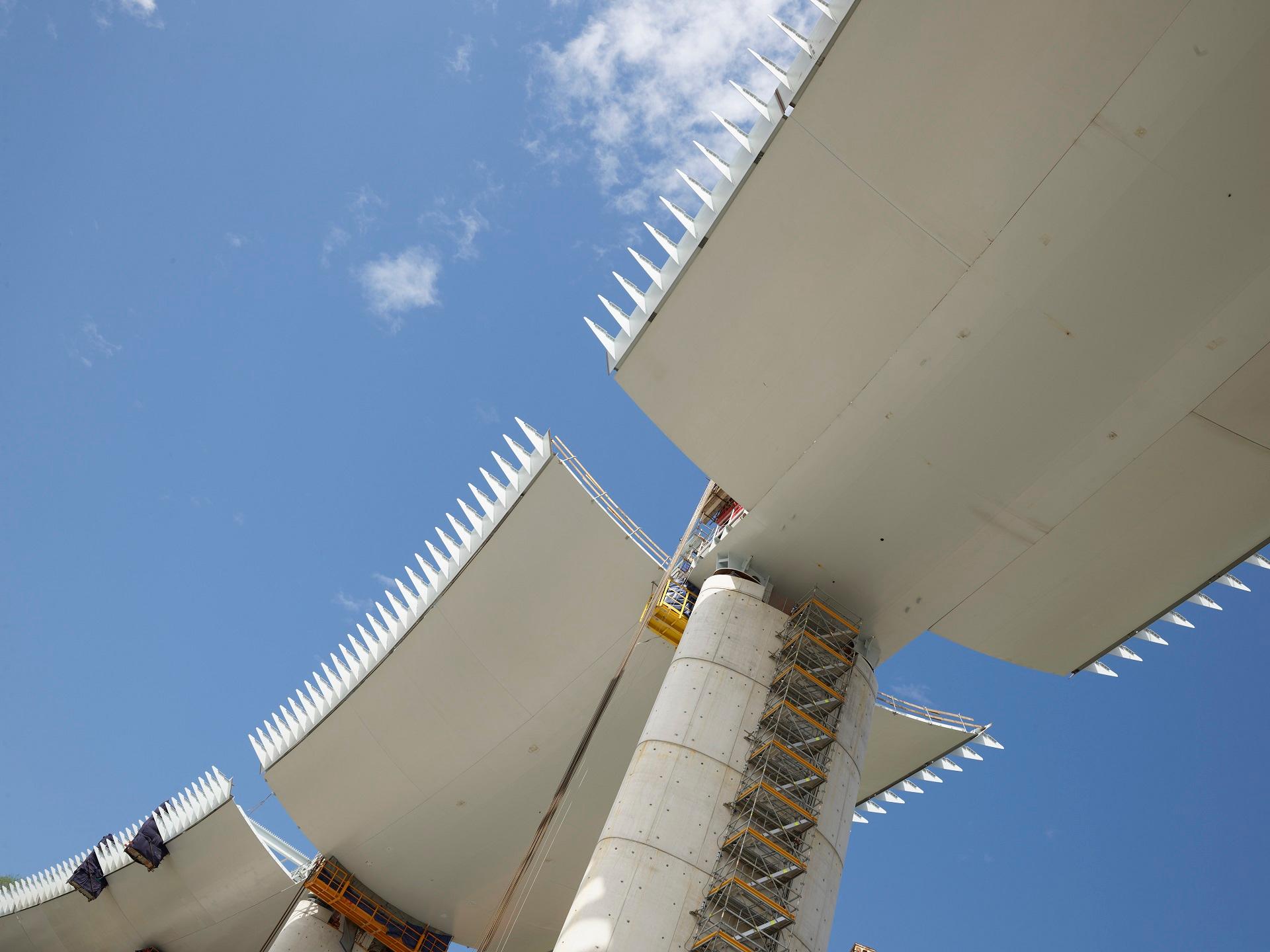
The Strait of Messina Bridge
The Bridge that connects Italy
World’s longest suspended bridge
The project involves the construction of the bridge with the longest suspended single span in the world. Its total length is 3,666 meters, while its span is 3,300 meters.
The bridge will have multimodal capacity, allowing the transit of both vehicles and trains. The deck will have a total width of approximately 60 meters, and the two towers will reach 399 meters in height.
The suspension system will consist of four cables, each 1.26 meters in diameter. The cables will be composed of steel wires whose combined total length will be 940,000 kilometres, equal to 2.5 times the distance between the Earth and the Moon.
The Strait of Messina Bridge, an extraordinary infrastructure development opportunity for the country
Engineer Explains How the World’s Longest Suspension Bridge Would Work | WSJ
How will Strait of Messina Bridge be like? The 3D video of the original projects – Geopop/Webuild

The Strait of Messina Bridge is a huge technological challenge. 3km of the Bridge will be suspended in the Strait, a magical place where it will be possible to meet the Magna Graecia. It is also the Italian challenge towards the rest of the world.
Q&A on the Strait of Messina Bridge
1. When did the Strait of Messina Bridge Project come to life?
The first international idea contest regarding the Bridge's building was called for by the Italian Public Works Minister in 1969. The work in final solution was identified in 1992 by the concessionaire company Stretto di Messina.
In 2003, the preliminary project was approved and in 2004, a European tender was called for design and build, which was later assigned in 2005. And 2006, the Società Stretto di Messina company awarded the design and build contract of the Bridge to the project company Eurolink S.C.p.A, which won the international tender and whose leading company and majority stakeholder is the Webuild Group.
On December 20, 2010, Eurolink S.C.p.A. delivered the final design after specific studies and analyses were concluded on the territory. On July 29, 2011, the Stretto di Messina company approved the final design. Works were stopped by Italian Law-Decree October 18, 2012, no. 179. Italian Law-Decree March 31, 2023, no. 35 (conversion law May 26, 2023, no. 58) established the restart of all activities aimed at building the Strait of Messina Bridge Project.
2. What are the Bridge's technical records?
The project involves the construction of the world's longest suspended bridge, measuring in overall length 3,666 metres, with a suspended span of 3,300 metres.
The deck's overall width measures approximately 60 metres and the two towers on the ground will reach 399 metres in height.
The suspension bridge will be made of twin cables, each measuring 1.26 metres and made of 44,323 steel wires.
3. How many vehicles and trains will cross the Bridge?
The Bridge will connect Sicily to Calabria where the two shores are closer, with a modern, reliable structure that will act of the link to create an integrated infrastructural system, serving the territory and citizens.
The deck will accommodate two roadways with 3 traffic lanes in each direction (two driving lanes plus the shoulder) and a double-track railway line, besides a service lane per direction. The Bridge will be open 365 days per year 24/7.
It will have a maximum capacity up to 200 trains per day and 6,000 vehicles per hour.
4. What are the engineering novelties foreseen by the 2024 Final Project Update for the Strait of Messina Bridge?
The project's concept and main features, which ensure, today just as in 2011, a level of technical requirements way more demanding compared to the standard applicable to “regular” infrastructures, has been kept unchanged in 2024 Report updating the 2011 Detailed Design
The Report describes several updates aimed to align the project with the in-force regulations (safety, health, environmental) and state-of-art technologies. Innovative solutions adopted in recent major suspension bridge projects. such as the Osman Ghazi bridge or the Çanakkale Bridge on the Dardanelles Strait in Turkey, the world's longest suspended bridge that features the same type of aerodynamically stable deck, the "Messina Type Deck", were also included.
5. What has improved in the last update with regard to environmental safeguard?
The studies carried out by Eurolink S.C.p.A. with regard to environmental protection greatly exceed current normative requirements, confirming what was already validated by the previous Environmental Impact Assessment procedures, both on the Preliminary Project and in the Final one, also in light of the novelties regarding the environmental, territorial and/or normative reference framework.
In particular, the updated detailed design includes a set of environmental compensation and mitigation measures aimed at improving the conditions of the environment affected by the works. River protection works are amongst those foreseen, like reforestation plans and rebuilding natural habitats in greater proportion compared to what was suggested by Italian ministerial guidelines.
6. What answers were given by the project's Scientific Committee?
The Scientific* Committee, just like in 2011, expressed its favourable opinion subordinate to the fulfilment of design recommendations.
Most recommendations will be included out, as requested, in the Construction design. Some of these recommendations, have in any case been already implemented in the integrative documents during the EIA procedure, specifically with regard to environmental matters.
It is a common understanding among all involved parties that the implementation of the recommendations by the Scientific Committee is perfectly compatible with the development of the Construction design and does not require substantial changes to the Detailed Design.
* The Scientific Committee is an independent body foreseen by the Law, with 9 experts appointed by the Italian Ministry of Infrastructure and Transport with the Region of Calabria and the Region of Sicily.
7. What was the outcome of the "Valutazione di Impatto Ambientale" (Environmental Impact Assessment) of the VIA Commission?
The Environmental Impact Assessment Technical Commission (Commissione Tecnica di Valutazione dell'Impatto Ambientale) gave a positive opinion regarding the environmental compatibility of the final project, as integrated with the Integrative Report (Relazione Integrativa) pursuant to Law-Decree 35/2023 on the restarting of procedures for the Bridge, in compliance with the environmental conditions that have been prescribed.
The Commission completed its activities, sending on November 13, 2024, its opinion regarding the stable connection between Calabria and Sicily that includes the Bridge and the road and rail connections on land.
The Commission, despite expressing a unanimous favourable opinion towards the Bridge project, as for all projects as complex as this one, also requested the implementation of 62 prescriptions to be largely carried out during the execution phase of the project. These prescriptions essentially concern studies, insights and details, or environmental monitoring.
8. Will the Bridge resist earthquakes?
Suspended bridges are the most seismic reliable structures since they have a low sensitivity to earthquakes. As a fact, a great number of this kind structure is built in areas of greater seismic hazard compared to the Strait of Messina, such as California, Turkey or Japan.
The Strait of Messina Bridge Project assumes PGA (peak ground acceleration) values greater than those expected by the applicable Italian building code for earthquakes with the same probability of occurrence.
9. Is it safe to build the Bridge's piers in the places chosen in the project?
The updated set of studies prepared by Eurolink for the Environmental Impact Assessment (EIA) procedure included the update of the geological report and confirmed that the two areas chosen for building the piers and the anchoring blocks of the cables, are stable and safe even from a geo-seismic-tectonic perspective.
The study has been carried out by the expert of the Dipartimento di Scienze della Terra of Rome's Sapienza University in collaboration with Istituto di Geofisica e Vulcanologia (INGV) researchers.
The Cannitello fault, as confirmed in the report of Rome's La Sapienza University and INGV, cannot be defined neither "Active" nor "Capable", in other words it does not reach the surface and cannot therefore interact with the structures built above it. Moreover, the fault does not intersect the foundation shafts of the pier on the Calabria side.
* Note: an active and capable fault is a fault that has experienced movement at least once in the last 40,000 years (active fault) and that can reach the topographical surface, producing a fracture/dislocation in the terrain (capable fault).
10. Are there other bridges built in seismic areas?
Building bridges in areas affected by significant seismicity is common. There are in fact many suspended bridges that resisted major earthquakes without being damaged. Notable examples include the Akashi Bridge in Japan, located near the epicentre of Kobe 1997 earthquake and the Osman Ghazi Bridge that crosses Izmit bay in Turkey, which was built in 2016 at just a few kilometres from the Kocaeli earthquake. The world's currently longest bridge, the Çanakkale Bridge, in Turkey, is located in an area characterised by significant seismic hazard (the Strait of the Dardanelles).
These examples demonstrate that it is possible to build safe and lasting structures even in highly seismic areas and complex geological contexts.
11. Can the Bridge resist extraordinarily strong winds and adverse weather conditions?
The Bridge is designed to resist wind forces with magnitude that have never been registered in the Messina Strait area. In particular, the project requires the Bridge to be aero-elastically stable for winds speeds at deck level equal to 270 km/h (75 m/s).
The tests carried out in some of the most important wind tunnels in the world (NRCC in Canada, BMS in England, FORCE in Denmark, and Milan's Polytechnic) demonstrated that the bridge, due to the particular deck structure - the Messina Type Deck - is stable up to a wind speed of 292 km/h.
Please note that the maximum wind speed (gust speed) registered during twenty years of monitoring in the Strait of Messina have never exceeded the speed of 144 km/h.
12. Will the Bridge allow the currently circulating large ships still to pass?
The clearance above the sea level of the deck of the Strait of Messina Bridge is 72 metres over a width measuring 600 metres. Such clearance is lowered down to 70 metres under normal traffic conditions with the full load of road lanes and two passenger trains passing simultaneously).
These parameters are in line or greater than those of existing bridges on the large international navigation routes.
13. Who are the designer team members who worked at the last updates?
The team of designers currently at work includes the world's maximum experts in the suspended bridge field, and it is practically the same as the team that followed the 2011 Detailed Design.
COWI, a famous Danish engineering firm that designed some of the most important suspended bridges in the last two decades, is the suspension bridge main designer.
The contract for design and build the Messina Bridge, was assigned at the end of a long tender process that took place internationally among the world's most competent companies in the sector.
14. How much will the Messina Bridge and the connection works cost?
The amount concerning the construction of the Bridge itself amounts to approximately 40% of the total amount of works that are included in the total investment amount stated in the 2025 financial law amounting to approximately 13.5 billion euros. The project also includes connections to the Sicilian and Calabria roadway and railway networks, and Mitigation and Environmental Compensatory Works.
In particular, on the Sicilian side, three underground railway station will also be built (Papardo, Annunziata, Europa) that, connecting to Villa S. Giovanni, Reggio Calabria and Messina will create the interregional mobility system of the area surrounding the Strait. In summary, a mobility network serving over 400,000 citizens of the Strait of Messina Area.
The Business Centre will be located in Calabria, in Piale, in the Municipality of Villa San Giovanni. It will serve as a multi-functional complex that will host activities connected to managing the Bridge project and services like shops, restaurants and meeting centres.
15. Is the Messina Bridge part of a larger Italian infrastructural investment plan?
The Messina Bridge is a strategic infrastructure that is part of a larger infrastructural development plan that Italy is delivering in the South of the country, both in Sicily, and on the continental side, with a total of approximately 120 billion euros in railway investments aimed at connecting Italy from North to South.
The European Union included the Strait of Messina Bridge Project in the Trans-European Transport Network (TEN-T), a set of integrated transport infrastructures foreseen to support the single European market and ensure free circulation, where Webuild just in Italy is building approximately 500 kilometres.
According to the most recent industrial plan of the FS Group (Italian Railways) of 2024, by the end of 2034 over 50 billion euros will be invested for improving the service quality of the railway network managed by RFI, with further 60 billion euros destined to transforming the actual network. ANAS (National Road Authority) will invest 40 billion euros for roads and motorways, of which 25 billion will be used for new works and 15 billion for improving the service quality.
16. When will works to build the Bridge begin?
The construction phase will be started following the approval of CIPESS (Comitato interministeriale per la programmazione economica e lo sviluppo sostenibile - Inter-Ministerial Committee for economic planning and sustainable development) of the Final Design and of the Updating Report, and the consequent re-activation of the Contract with Eurolink.
Concomitantly to the first stage of the Construction design, being a common practice, preliminary activities will be carried out to building the work: i.e. local roads, utilities diversions, explosive residues detection, archaeological investigations, geo-gnostic and geo-technical surveys, and the preparation of construction sites.
17. How will legality be managed?
Legality is core and is one of the cardinal principles that guides the Eurolink S.C.p.A. project company and its majority shareholder, Webuild, in bringing the business model forward.
A set of initiatives aimed at the maximum collaboration with institutions and the police force, to ensure information synergy as a means to, within one's activity perimeter, keeping legality monitoring always active.
18. How was the occupational forecast drawn-up for the project?
It is estimated that an average of 4,300 workers will be hired in the construction site every year. This number will reach 7,000 workers during the peak production period. To build the work, a total of over 100 thousand people will be employed.

The bridge in numbers
+ + +
Total length
+ + +
The suspended span
+ + +
Width of the deck
+ + +
Height of the towers
Construction phases of the Bridge
Come è fatto il ponte sospeso più lungo del mondo?
Strait of Messina Bridge, the numbers of the project

